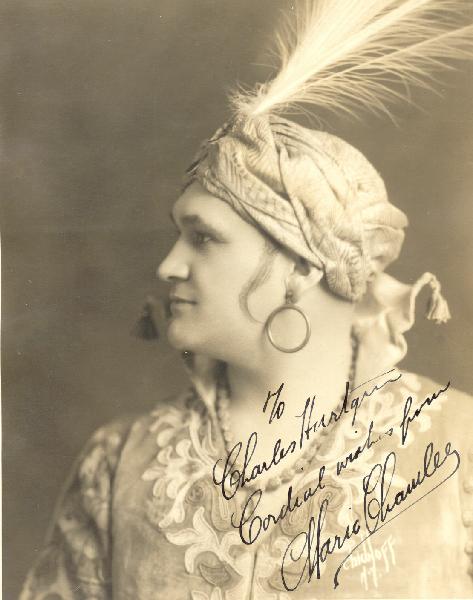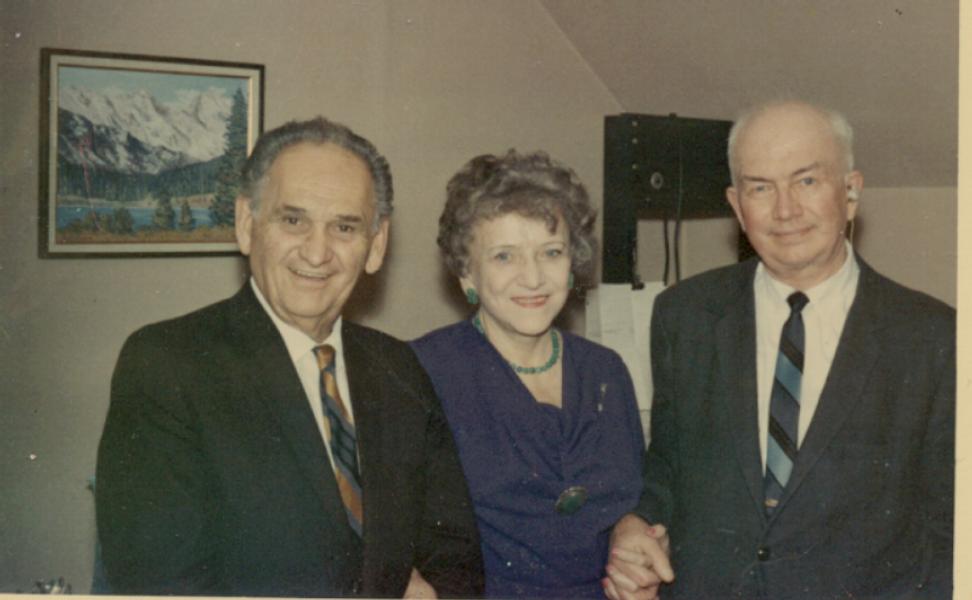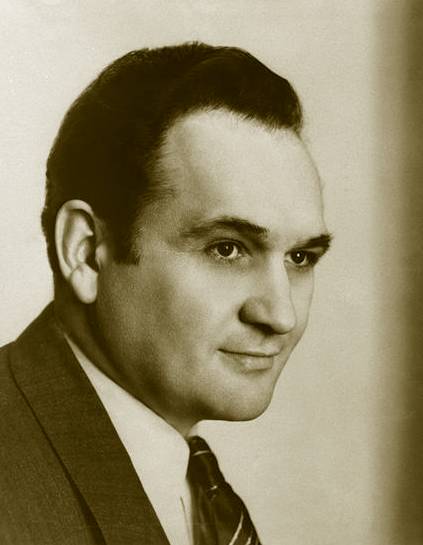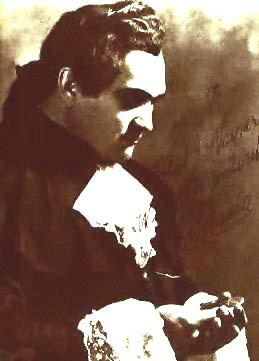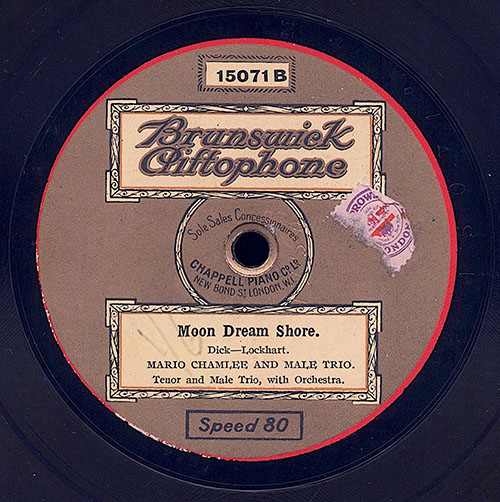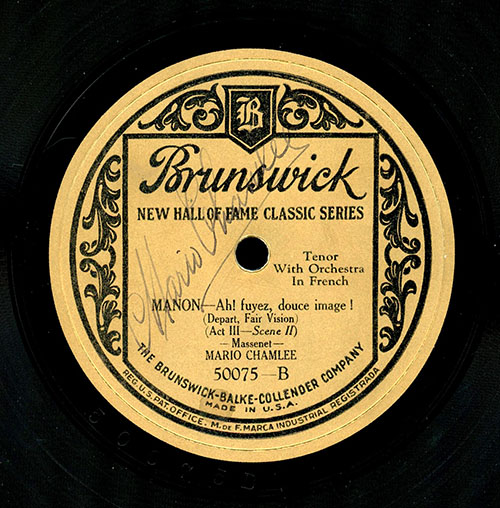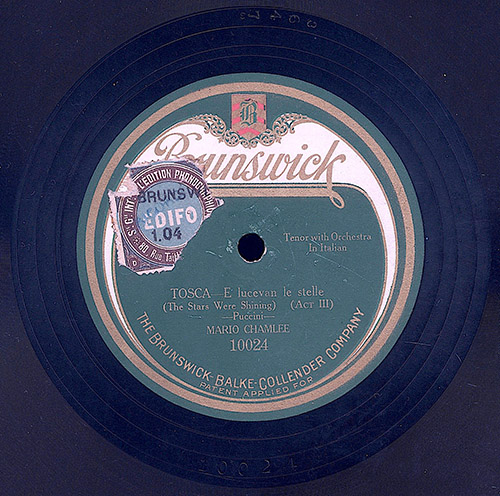Archer Ragland Cholmondeley Chamlee was born in Los Angeles, California, on May 29th, 1892. He was the son of a Los Angeles
physician Mr. Samuel Chamlee (descendent of an immigrant English family that had settled in Tennessee in 1700) and Mrs. Clara
Hausteib Cholmondeley.
Like most Americans he was educated in public schools. His musical gift was evident at an early age, but his interest was
centered on the violin, which he studied under Schonstein from the age of eight until he was twenty. He continued his studies
at the University of Southern California but all this time it never occurred to him that he could sing. His voice was
discovered when he stood in for an indisposed soloist while touring with the U.S.C. Minstrels. It was apparent that the young
man's voice was of unusual calibre, and encouraged by his friends, on returning to Los Angeles he auditioned for maestro
Achille Alberti who had once studied with the noted Italian baritone Antonio Cotogni. He studied voice and repertoire, during
five years, with Alberti.
At 23 years old, on January 12th, 1916, he made his operatic debut as Edgardo in "Lucia di Lammermoor" at the National Grand
Opera Company (also called "Lombardi Opera Company"). Such was his success that he decided to go to New York for further
studies with Gabriele Sibella and Riccardo Dellera. In March 1917, he made a second debut in San Francisco, as the Duke in
"Rigoletto". It was also in 1917 that Mario met the soprano Ruth Miller while on tour with the Aborn Opera Company. The
company included the baritone Richard Bonelli.
He had to interrupt his career when the United States entered the First World War and served as a member of the 77th Division
of the American Expeditionary Forces in France for 18 months (1917–19).
One day, while singing in a church, in France, his voice attracted the attention of some officers who immediately assigned him
to sing with the Argonne Players, to entertain the soldiers.
Back in America he started to sing again with some minor companies and also in vaudeville acts in which he sang opera arias.
Appearing in his vaudeville sketch, he was heard by Antonio Scotti and engaged for his own touring "Scotti Grand Opera Company".
Chamlee made his debut with this company in October 1919 at the Whiting House Theatre in Syracuse as Turiddu in "Cavalleria
rusticana" with Florence Easton and Millo Picco. He sang in eight cross-country tours of the U.S.A. and Canada between 1919
and 1922. He added to his repertoire the roles of Cavaradossi in "Tosca", Win-San-Lay in "L'oracolo" and Edgardo in "Lucia"
with the Spanish soprano Ángeles Ottein and the Italian baritone Mario Laurenti.
It was also in 1919 that he met again his future wife, the soprano Ruth Miller (1892–1983), who was singing with the
Cosmopolitan Opera Company at the Garden Theatre. They appeared together with the troupe, in Detroit, singing "Faust". They
married on October 2nd, 1919, though the wedding was kept in secret during a month until the news appeared on the New York
Times, in November. (The couple had a son, Dr. Archer Mario Chamlee Jr., born in 1921.)
On reaching New York, Scotti took Chamlee to audition for Giulio Gatti-Casazza. He was engaged on the spot, despite the fact
that the Metropolitan was well stocked with excellent tenors: Martinelli, Gigli, Lázaro, Lauri-Volpi, Schipa, Crimi,
Hackett, Harrold, Zerola... and, of course, Caruso. He made his Metropolitan debut on November 22nd, 1920 as Cavaradossi in
"Tosca" with Geraldine Farrar and Antonio Scotti. He was enthusiastically received and it was instantly noticed that the
youthful tenor's voice bore a striking resemblance to the tones of the great Caruso. The following day, the critic W. J.
Henderson of the "New York Sun" wrote about his "fresh" voice and "lyric qualities of merit". Pitts Sanborn of the "New York
Globe" wrote: "Mr. Chamlee ... revealed a voice which in its purity of timbre, combined with a well recognizable warmth and
richness, actually suggested the super-tenor of the great Enrico ... he showed surprisingly good command of his resources,
including his breath, and manfully refrained from forcing tones or indulging in sobs and shrieks and other cheap devices for
capturing the favor of the thoughtless. He sang sincerely, honestly, musically, and with techinical skill and soundness
of taste that became steadily more manifest as the evening advanced ... Beauty of voice, a true legato, a fine respect for the
musical phrase were revealed ... the achievement crowned a really very promising debut. Today the most cordial wishes of all
lovers of opera go both to Mr. Gatti-Casazza and to his 'young Caruso'."
Chamlee remained for 14 seasons at the Met, singing 23 different roles and a total of 219 performances. A curiosity, his
second performance at the Met was not an opera, but the tenor solo in Verdi's "Requiem" with Emmy Destinn, Jeanne Gordon and
Léon Rothier. He sang from 1920 to 1928, and his other operas included "Rigoletto", "Madama Butterfly" (with Farrar and
Scotti), "Lucia di Lammermoor", Win-San-Lay in "L'oracolo", Christian Brehm in the American première of "The Polish
jew" (Der polnische Jude) by Leon Weiss, "Faust" (with Easton, De Luca and Rothier), "Mefistofele" (with Easton and Didur),
"Il barbiere di Siviglia" (with Ottein, Ruffo and Mardones), "La bohème" (with Bori, Scotti and Rothier), "Manon" (with
Farrar, De Luca and Rothier), "Cavalleria rusticana" (with Maria Jeritza), "La traviata" (with Bori and De Luca), Grigorij in
"Boris Godunov" (sung in Italian!) with Fjodor Shaljapin, José Mardones and Margarete Matzenauer), Vasco da Gama in
"L'africana" (with Ponselle, Queena Mario, De Luca and Didur), "La Gioconda" (with Rosa Ponselle, Jeanne Gordon, Giuseppe De
Luca and José Mardones), "Les contes d'Hoffmann" (with Lucrezia Bori, Marion Talley, Mary Lewis, Giuseppe De Luca,
Adamo Didur and Léon Rothier) and Wilhelm Meister in "Mignon" (with Bori, Talley and Whitehill). Then he left the Met,
due to differences over repertoire, but returned in 1936.
In 1923, Mario Chamlee sang in Europe at the Deutsches Theater in Prague and at the Volksoper in Vienna in "La bohème",
"Tosca", "Rigoletto", "Faust", "Lucia" and "La traviata". The reviewer of the Neuigkeits-Welt-Blatt wrote: "Chamlee is a
singer of extraordinary vocal culture, from whose throat float effortless, brilliant sparkling tones which caress the ears of
his audience. It was one of those evenings never to be forgotten." Though he did not sing at Covent Garden, he was heard at
London's Royal Albert Hall in 1925, when the quality and power of his voice drew enthusiastic response from the press which
characterised him as a great singer. After leaving the Met in 1928, Chamlee returned to Europe and made his debut at the
Opéra in Paris in the title role of Henri Rabaud's "Mârouf" on 5 April 1929, when the beauty of his voice and
the sweetness of his singing and cultured style brought down the house. Less than a week later the tenor made another debut,
now at the Opéra-Comique as des Grieux in Massenet's "Manon". He obtained excellent reviews from the French press which
thought his singing and acting quite brilliant. Later in the same year, he appeared as "Mârouf" at La Monnaie in
Brussels, where a reviewer wrote that his singing "was on parallel in every way with the greatest singers
of all time". He also sang in Liége, Lille and Bordeaux.
In America, Chamlee sang during nine summer seasons at Ravinia Park on the shores of Lake Michigan (Chicago). At that time,
music critic Edward Moore wrote: "Mario Chamlee has the best tenor voice of any living American." In those summer seasons,
Chamlee had the opportunity to sing some new roles, like Lyonel in Flotow's "Martha" (29 June 1927) with Florence Macbeth and
Virgilio Lazzari (in Italian); Araquil in Massenet's "La Navarraise" (6 July 1927) with Ina Bourskaya and Léon Rothier;
the title role in Auber's "Fra Diavolo" (9 July 1927) with Florence Macbeth, Virgilio Lazzari and José Mojica; the
title role in Rabaud's "Mârouf" (1st August 1928) with Yvonne Gall and Léon Rothier; Gennaro in Wolf-Ferrari's
"I gioielli della Madonna" (10 August 1928) with Florence Easton and Mario Basiola; Pedro in Vittadini's "Anima allegra" (21
July 1930) with Lucrezia Bori and Florence Macbeth; Jenik in Smetana's "Prodaná nevěsta" (sung in German, in
1930) with Elisabeth Rethberg; and Count Gil in Wolf-Ferrari's "Il segreto di Susanna" (18 July 1931) with Lucrezia Bori. The
role of Count Gil was assigned to Chamlee though it is usually sung by a baritone. Of course he also sang his usual
repertory: Rigoletto, Cavalleria rusticana, Manon, Il barbiere di Siviglia, Lucia di Lammermoor, Les contes d'Hoffmann, La
traviata, La bohème and Tosca.
He sang in San Francisco and Los Angeles in 1927, 1931, 1932 and 1934, making his debut in Gounod's "Roméo et
Juliette" (3 October 1927) with Florence Macbeth, Desire Defrere and Ezio Pinza. The reviewer of Los Angeles said: "Mario
Chamlee sings with freedom and ardor. In appearance, Chamlee is no prepossessing Romeo, but histrionically this California
artist, too, has advanced so that he could fascinate his audience." During those Californian seasons he was also heard in "La
bohème", "Tosca" (with Yvonne Gall and Giuseppe Danise), "Cavalleria rusticana", "La traviata" (with Claudia Muzio and
Richard Bonelli), "Prodaná nevěsta" (1934, in German, with Rethberg) and as Don José in "Carmen", perhaps
for the first time in his career, with Ninon Vallin and Ezio Pinza (8 and 17 November 1934).
In San Francisco, Chamlee made his first excursion into the Wagnerian field in October 1932 as Lohengrin and as Walther von
Stolzing in "Die Meistersinger von Nürnberg".
On 15 January 1931 he returned to London singing as a soloist in Verdi's "Requiem" conducted by Arturo Toscanini.
On 27 December 1932 Chamlee sang for the first time at the Chicago Opera, in "Madama Butterfly" with Elisabeth Rethberg. He
sang there from 1932 to 1936 and he was also heard in "Cavalleria rusticana", "La Gioconda", "Pagliacci" (probably for the
first time in his career), and "La bohème". On 12 November 1935 he sang "Lohengrin" with Lotte Lehmann, Eleonora La
Mance, Schiffeler and Chase Baromeo, and on 4 December 1936 he sang "Prodaná nevěsta". His last appearance in
Chicago was in a single performance of "Prodaná nevěsta" on 15 December 1939.
In 1936, after an absence of eight years, he returned to the Metropolitan Opera as Jeník in "Prodaná
nevěsta" (sung in English) on 15 May 1936 (with Muriel Dickson and Lucielle Browning). On 4 February 1937, he was
chosen for the title role in the world premiére of "Caponsacchi" by Richard Hageman (with Helen Jepson, Lawrence
Tibbett and Norman Cordon). On 21 May 1937, he sang "Mârouf" (with Norman Cordon), and on 3 March, he took the role of
the lover in the Metropolitan premiére of "Amelia goes to the ball" (Amelia al ballo) by Giancarlo Menotti. The opera
was sung in English and in the cast were Muriel Dickson, John Brownlee and Norman Cordon (7 performances). His last
performance at the Met was in that same opera, "Amelia goes to the ball", on 30 January 1939. He retired though he was only 47
years old.
However, he continued to appear in opera until 1942, when he was last seen in "La traviata" in Seattle with Jarmila
Novotná and Richard Bonelli. He also appeared in concert, often with his wife Ruth and Richard Hageman at the piano,
and also during the '30s and '40s, he sang frequently on the radio and participated in the "Tony and Gus Radio Talk-Show".
Leaving the stage, he returned to Los Angeles and opened a successful singing academy with his wife in 1940, "Casa Chamlee",
from which singers like soprano Mary Costa and baritone Theodore Upmann emerged.
During the Second World War, Mario Chamlee sang for the soldiers as a member of the USO (United Services Organization).
Chamlee received many honours in life, such as "Master of Music" of the University of Southern California (1924) and in 1948
member of the Music Faculty of the same university, where he taught for a time.
He returned to the Metropolitan stage as a guest on two more occasions late in his life. On 20 November 1963 for a gala
performance commemorating the 50th anniversary of Giovanni Martinelli's debut at the Met. And on 16 April 1966 for the gala
farewell from the Old Met at Broadway and 39th Street.
Mario Chamlee died in Hollywood on October 13th, 1966 at 74 years old. His wife, Ruth Miller, survived him for 17 years and
died in 1983.
JUAN DZAZÓPULOS, May 2008
